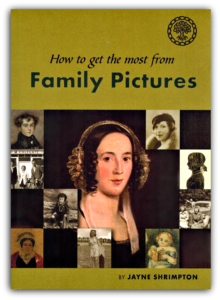
In this well-illustrated guide, professional dress historian and picture specialist Jane Shrimpton analyzes more than 200 images—paintings, drawings, silhouettes, and photographs.
How to Get the Most from Family Pictures. By Jayne Shrimpton. Softbound (2011), 367 pp., indexed. £12.99. Published by the Society of Genealogists Enterprises Ltd, 14 Charterhouse Buildings, Goswell Road, London EC1M 7BA England.
Review by James Pylant
The fashion worn by our ancestors while sitting for a portrait tells us about their wealth, status, and aspirations. Clothing, hairstyle, and jewelry offer the best evidence for dating a portrait. “It is rarely possible to discover the precise year of an unmarked photograph, but a close date range of a few years is a realistic objective,” says Jayne Shrimpton, author of How to Get the Most from Family Pictures. A professional dress historian and picture specialist, she offers photographic analysis at the annual event, “Who Do You Think You Are? Live.” It was while working at the National Portrait Gallery in London, identifying photographs and artwork and handling requests from the public, that she realized how little was known of local artists of the 19th and 20th centuries and their subjects—the “ordinary” people they depicted in portraits.
In this well-illustrated guide, with a special emphasis on British images, Shrimpton presents examples of more than 200 images—paintings, drawings, silhouettes, and photographs—carefully analyzing the subjects. Documents gathered by genealogists often aid in understanding more about historical images. They may signify a birthday, a christening, a wedding, or even a death. One photograph examined by the author depicts a couple whose clothing signifies a time of mourning. The clothing style points to the late 1890s, while research reveals their young daughter died in 1897. The couple apparently wanted to formally mark the sad occasion by sitting for a photographer.
An important factor in identifying an unmarked photograph understands the processes developed during certain years, as well as the types and formats. Daguerreotypes, for instance, were most common between 1845 and 1855, but they were in use from 1841 until around 1865. Ambrotypes, on the other hand, were most common between around 1855 to 1865, though they may date as early as 1852 and as late and the 1890s. Cartes de visite (photographic prints pasted onto card mounts) were mass-produced from about 1859 until 1919, though they were popular especially between the early 1860s until 1908. They are of special significance to the family historian due to the fact that our ancestors were more likely to afford them, as well as an even cheaper photographic process: tintypes.
How to Get the Most from Family Pictures also offers expert advice on preserving, copying, sharing, and publishing and storing family pictures, as well as the care of oil portraits, prints, drawings, and watercolors.
Also available from Amazon.com (affiliate link).
Book Review Policy and Disclosure of Material Connection: GenealogyMagazine.com receives complimentary copies of books and samples of products and services mentioned on its sites with the understanding that it will be considered for review by the editors. The editors will only recommend products which they feel are of benefit to the site’s readers. This disclosure is made in accordance with the Federal Trade Commission’s 16 CFR, Part 255: “Guides Concerning the Use of Endorsements and Testimonials in Advertising.” Some of the links in the posts on GenealogyMagazine.com are “affiliate links,” meaning that if a site user clicks on the link and purchase the item, GenealogyMagazine.com will receive an affiliate commission. Regardless, we will only recommend products or services that we would personally use and believe will add value to our readers. We are disclosing this in accordance with the Federal Trade Commission’s 16 CFR, Part 255: “Guides Concerning the Use of Endorsements and Testimonials in Advertising.”
